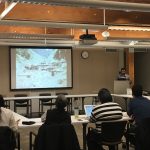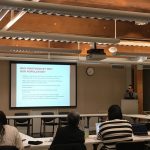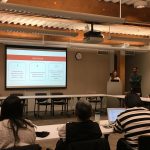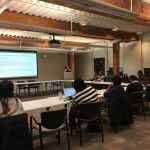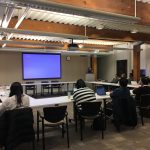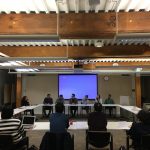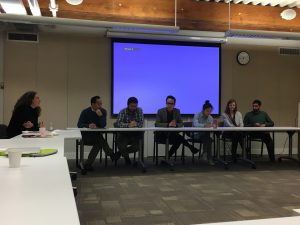
Photo by Mapem Lanigan
Speakers: Omer Aijazi, Kia Dullemond, Armaan Malhotra, Monica McKeown, Dhondup Tashi Rekjong, Bendi Tso/Yujie Ji
The student research roundtable discussion was the Himalaya Program’s first event of 2017. UBC students from various disciplines, including Medicine, Anthropology, Educational Studies, and Asian Studies, were invited to share their research with members of the UBC and Himalaya Program communities.
Omer Aijazi, a graduate student specializing in recovery and social repair following natural disasters, discussed his research on Neelum Valley in Pakistan administered Kashmir. He posed the question: How do survivors reconstruct and piece their lives back together? In Neelum Valley, Aijazi’s research focused on how the inaccessibility of the region has contributed to its unique political fabric as a collection of decentralized spaces. Aijazi also explained how the landscape contributed to the processes of social repair, “both public and private intimacies were nurtured by the landscape.” In addition to this, the unique landscape of Neelum Valley promotes interconnectivity and mobility within the community.
Kia Dullemond, a graduate student in the Faculty of Medicine at UBC, presented the qualitative research project, Photovoice. The aim of the project was to determine perspectives on health of children at the Sonrisa orphanage. Dullemond explained that in this research project, the means of generating data were placed in the hands of participants, encouraging agency over their identities and voices. Children at the Sonrisa orphanage were given disposable cameras and asked to take photos of behaviors that they thought were healthy and unhealthy. After two days, the children participated in focus groups that were facilitated with the help of translators. These focus groups allowed Dullemond and the other researchers to gain a better understanding of how the children understood their own health and the health of their communities. Dullemond explained that the research project’s findings indicated that although the children were aware of what behaviors were healthy and unhealthy, they also revealed gaps in how the children understood the purpose of these behaviors.
Armaan Malhotra and Monica McKeown, students at the UBC Faculty of Medicine, visited Nepal in 2016 as part of a team of students to research Sickle-Cell Disease (SCD) in the indigenous Tharu community. The results of the project indicate that there is a 9.3% prevalence rate of the sickle cell trait within the Tharu community.
The first phase of the project was conducted in 2015 and involved community screening for the disease. Alongside Nepali health professionals, the team collected blood samples from more than 2900 participants, which was one of the largest health screenings in Nepal’s history. Those who tested positive for the trait were then invited to participate in information sessions about the disease and how to manage it.
The second phase of the project was conducted in 2016 and aimed to collect more qualitative data on knowledge retention about SCD from the previous year. The team held interviews with participants from the first phase of the project, and the findings underscored the importance of education. The team found that there was a significant amount of confusion surrounding screening and diagnosis, as well as transmission of the disease. These findings helped them develop learning materials about the disease to teach to villagers, health care providers, teachers and students within the community.
Malhotra and McKeown also shared with the audience that they were currently working on improving the sustainability of the project. As they explained in the discussion, financial dependence on foreign funds is not sustainable. Thus, the project is now working towards fellowships for community members.
The study and screening program developed by the team of Nepali healthcare professionals and UBC students is the first of its kind in Nepal, and is working to implement a nationwide neonatal SCD screening program in the country.
Dhondup Tashi Rekjong, a graduate student at the Department of Asian Studies at UBC, discussed his research on the Tibetan intellectual Muge Samten, who played a pivotal role as a renowned intellectual in post-colonial Tibet. Much of his work dealt with the preservation of Tibetan language and history, and the challenging of linguistic reforms.
In the 1950s, Tibet was incorporated into the People’s Republic of China. Under Chinese control, there were issues with administration and the sociolinguistic aspect of governing Tibet. In Tibet, communism was a foreign ideology and there were no linguistic ways to communicate communism to the Tibetan people. The Chinese government began to recruit Tibetan intellectuals to translate these communist ideologies, beginning with the translation of dictionaries to propagate communism. Muge Samten was one of the Tibetan scholars who was recruited to contribute to this effort.
Although Muge Samten cooperated with these efforts, he disagreed and criticized Chinese proposals to reform Tibetan grammar by minimizing Tibetan particles and replacing them with Chinese particles. Muge Samten pointed out these changes and openly criticized them.
Rekjong explained that one the one hand, Muge Samten collaborated with the Chinese government, and translated and propagated communist ideas. However, he also criticized communist China, and thus played a dual role in post-colonial China’s history. Rekjong explained that Muge Samten’s controversial role in Tibetan and Chinese history contributes to his legacy as a scholar and intellectual.
Yujie Ji (Bendi Tso), a graduate student in the Department of Anthropology, discussed how China’s language policy has had enduring impact on the linguistic lives of Chone communities.
Based on interviews and observations conducted between May and August 2013 in Luozu Village, Chone County, Kanlho Tibetan Autonomous Prefecture, Gansu Province, China and a series of follow up interviews between October and December 2016, her project traces the trajectory of China’s language policy as it is played out in Chone and explores its impact on local Tibetans’ language practices and ideologies.
Her findings indicate that through China’s language policies which become embodied in daily language practice, Tibetans in Luozu village in Chone County live under the dual linguistic hegemony of both Chinese and standardized Amdo Tibetan. On the one hand, China’s language policy works to effect a language shift from Chone Tibetan to Chinese and also to promote a standardized Amdo Tibetan language. On the other, these same policies lead to the endangerment of the Chone Tibetan language. This unusual situation has led Chone Tibetans to have internalized a fatalistic view of their heritage language and resulted in a belief that their heritage language is “shallow”. Her study sheds light on how language functions to construct and reproduce social and cultural power, which in turn guides and shapes people’s language practices. It also addresses the wider issue of Tibetan linguistic diversity.
This event was sponsored by the Himalaya Program and the Department of Asian Studies.
Photos by Mapem Lanigan
